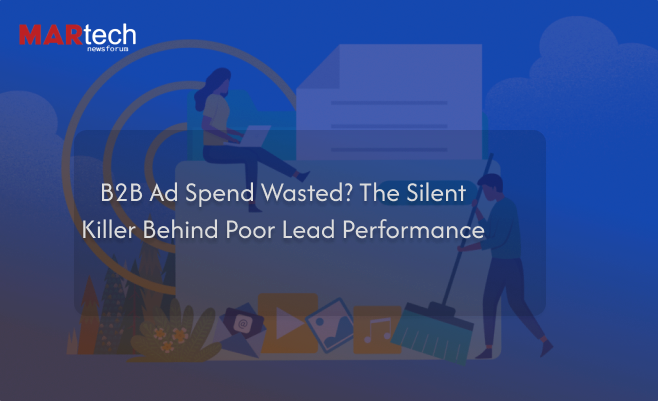
In the ever-evolving world of B2B marketing, digital advertising has become a cornerstone of growth strategies. From LinkedIn campaigns to programmatic display, B2B marketers are spending aggressively—often with budgets that rival those of their B2C counterparts. Yet, behind the numbers lies a sobering reality: a staggering portion of B2B ad spend is underperforming or completely wasted.
The root cause? Poor lead performance—a silent killer that drains resources, deflates morale, and erodes trust between marketing and sales teams. While campaigns may generate engagement and even high lead volumes, the quality of those leads frequently falls short of expectations. In an ecosystem where every dollar is scrutinized, this inefficiency can no longer be ignored.
The Hidden Cost of “Good Enough” Leads
B2B organizations often celebrate metrics like cost-per-lead (CPL) and click-through rate (CTR). But beneath these vanity numbers lies a fundamental disconnect: volume does not equal value.
Marketing teams may generate hundreds or even thousands of leads from paid campaigns, but sales teams often struggle to convert those leads into meaningful pipeline. Why? Because many of these leads:
- Do not match the Ideal Customer Profile (ICP)
- Come from non-decision-makers or irrelevant industries
- Show no intent to buy, now or ever
- Fail to respond to outreach altogether
This misalignment creates friction, wastes time, and damages the credibility of marketing efforts. Even worse, it distorts performance reporting and makes it harder to identify the true ROI of advertising spend.
What’s Going Wrong? The Core Issues Behind Lead Failure
B2B lead quality issues don’t stem from a single failure point. Instead, they’re the result of multiple weaknesses across the advertising and lead generation process. Some of the most common silent killers include:
1. Outdated or Inaccurate Targeting
Many advertisers still rely on static buyer personas or broad demographic filters when building campaigns. These outdated models fail to reflect the complexity of modern B2B decision-making, especially in account-based sales cycles.
2. Fragmented Data Ecosystems
When ad platforms, CRMs, and marketing automation tools don’t speak the same language, it’s impossible to track and refine lead quality across the funnel. This fragmentation leads to blind spots and duplicate efforts.
3. Over-Reliance on Form Fills
Forms may generate contact information, but that doesn’t equate to intent. In many B2B campaigns, form fills are used as the sole success metric, ignoring whether leads are qualified, engaged, or sales-ready.
4. No Real Sales Feedback Loop
Without structured sales feedback on lead quality, marketing teams continue to optimize for volume rather than conversion. This creates a cycle of inefficiency where bad leads are recycled and budget is burned.
5. One-Size-Fits-All Messaging
Generic ad creatives and landing pages fail to engage nuanced B2B audiences. When messaging doesn’t speak to specific roles, pain points, or stages of the buyer journey, conversion rates drop—even among qualified prospects.
Why the Problem Persists: Institutional Blindness
What makes this issue especially dangerous is its subtlety. Most organizations don’t realize how much money they’re losing because on the surface, campaigns seem to be working. Dashboards light up with leads. Budgets are spent. Reports are filed. Yet few pause to ask: Are these leads actually turning into customers?
This disconnect stems from an institutional bias toward surface-level metrics and a reluctance to challenge the status quo. In many marketing departments, success is still defined by activity rather than outcomes. The deeper performance metrics—opportunity creation, pipeline velocity, customer acquisition—are either ignored or improperly attributed.
The Impact: Budget Burnout and Team Misalignment
When poor lead performance becomes the norm, the consequences are far-reaching:
- Marketing teams lose credibility with sales counterparts and leadership
- Sales teams become disillusioned and deprioritize marketing-sourced leads
- Budgets are cut due to perceived underperformance
- Revenue targets are missed, despite strong campaign activity
This is more than a technical or tactical issue—it’s a strategic threat to long-term business growth.
The Solution: Fixing Lead Quality at the Source
Solving the lead performance problem starts with a mindset shift: from volume-first to quality-first. Here’s what B2B marketers must do to reverse the trend and reclaim ROI on ad spend:
1. Redefine Lead Qualification
Move beyond basic demographic filters. Define leads based on real buyer intent signals, fit within your ICP, and engagement behavior. Marketing and sales must jointly agree on what constitutes a qualified lead.
2. Adopt Intent Data and Predictive Targeting
Modern platforms now offer access to real-time intent data, showing which companies are actively researching relevant topics. This allows marketers to focus spend on accounts showing actual buying behavior, not just demographic fit.
3. Build Full-Funnel Visibility
Ensure that all marketing campaigns are tied to sales outcomes. This means integrating advertising platforms with CRM and sales tools to track lead progression, opportunity creation, and revenue attribution.
4. Align Messaging to the Buyer Journey
Tailor ads and landing pages based on persona, industry, and funnel stage. A CFO looking to reduce costs should see a different message than an IT leader exploring automation tools.
5. Create a Continuous Feedback Loop
Sales and marketing must be in constant dialogue about lead quality. Implement structured reporting where sales can score leads post-contact, and marketing can use that data to optimize targeting and messaging.
Looking Ahead: Ad Spend With Purpose
B2B advertising is not cheap—and it shouldn’t be. But it also shouldn’t be wasteful. In an era where every dollar is tracked, the only way to maximize ROI is to treat lead quality as a strategic priority.
Marketing leaders must look beyond surface metrics and dig deep into what truly drives revenue. That means better targeting, smarter technology, tighter sales alignment, and an obsession with relevance at every stage of the buyer journey.
The time to act is now. Every wasted lead is a missed opportunity—and every misaligned campaign is a step away from growth.